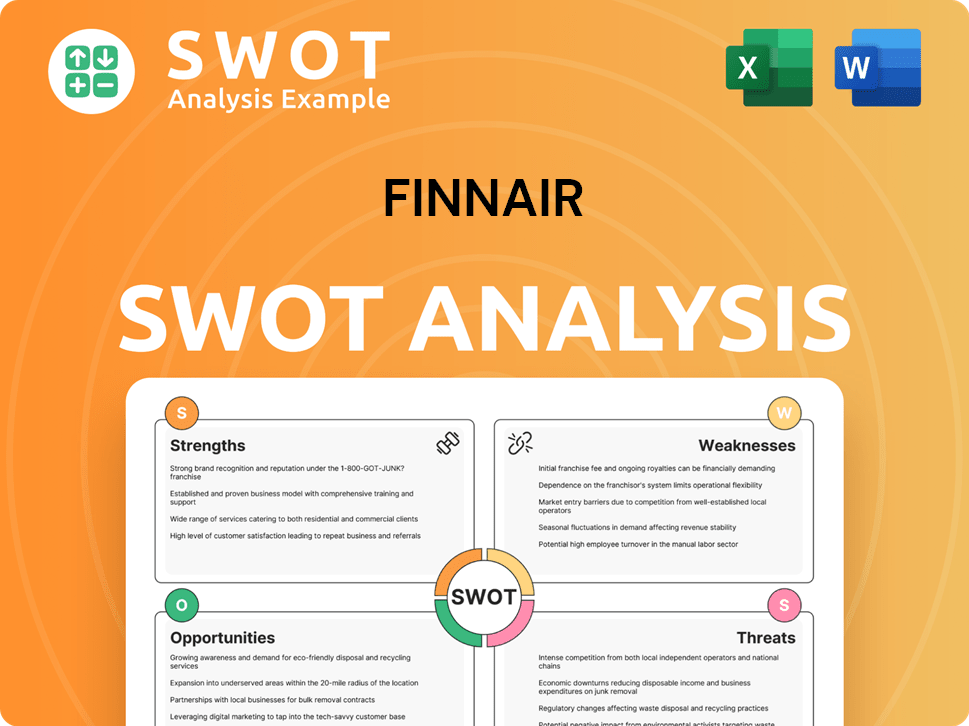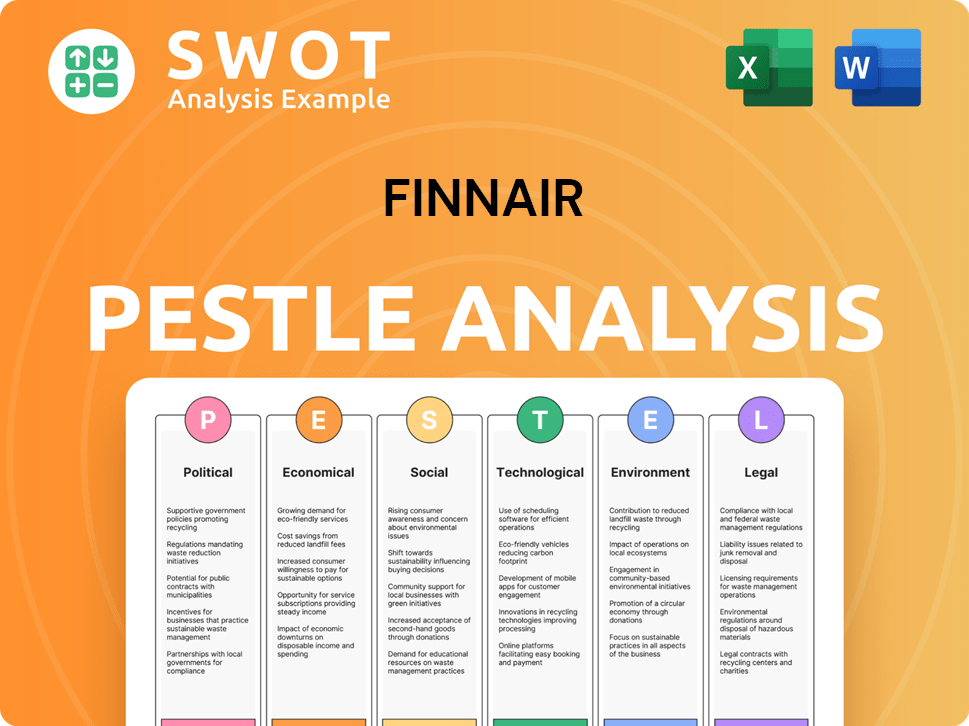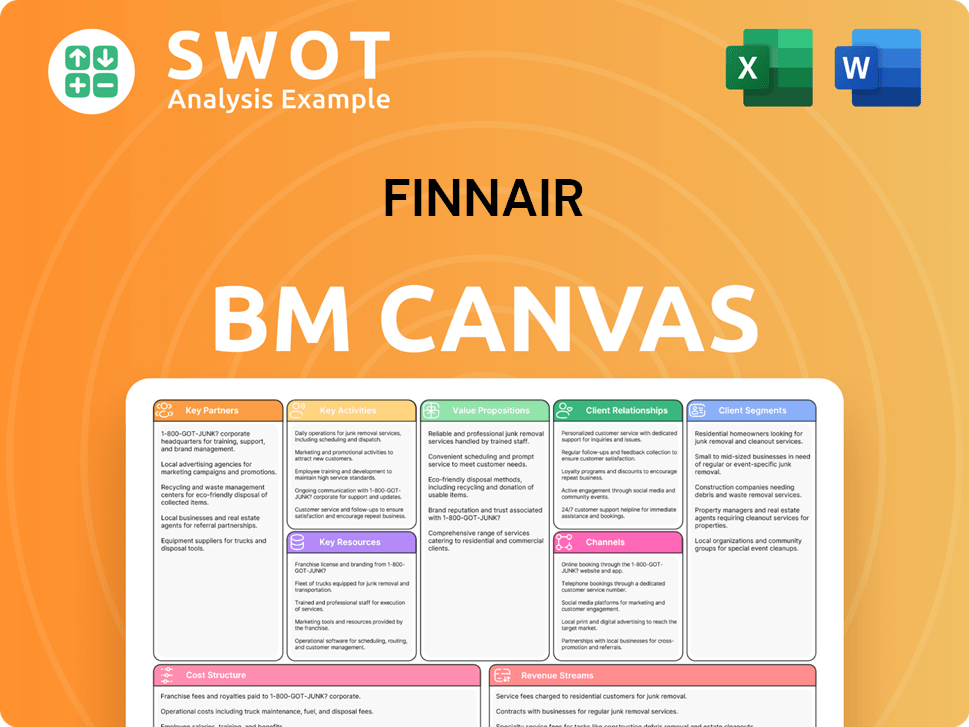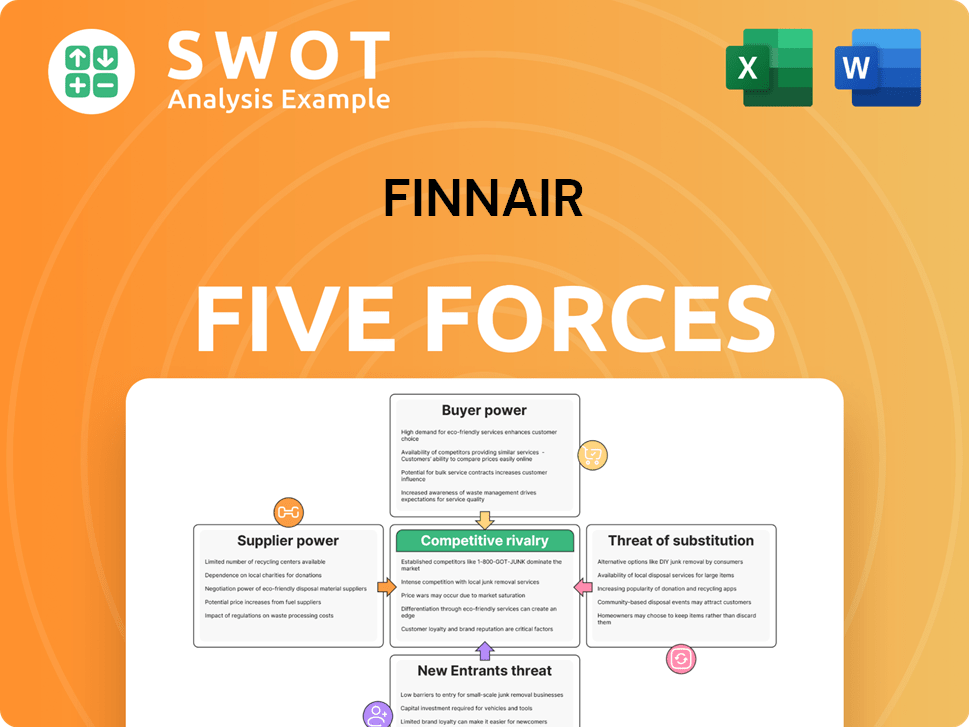Finnair Bundle
How Has Finnair Adapted to Serve Its Evolving Customer Base?
In the ever-changing landscape of the airline industry, understanding customer demographics and the target market is crucial for success. Finnair, the flag carrier of Finland, faced significant challenges after the closure of Russian airspace, which reshaped its strategic focus. This shift required a deep dive into its Finnair SWOT Analysis to understand how to best serve its customers.

This exploration delves into who Finnair's typical customers are, examining their origin, age range, and income levels. We will analyze Finnair's market segmentation and customer profile to uncover the airline's strategies for attracting business class and leisure travelers. Furthermore, we will examine the travel habits of Finnair's audience, including their preferences for in-flight services and the effectiveness of its customer loyalty program.
Who Are Finnair’s Main Customers?
Understanding the customer demographics of Finnair involves analyzing its passenger and cargo services, which cater to both business-to-consumer (B2C) and business-to-business (B2B) segments. While specific details on customer age, income, or family status are not publicly available, the airline's strategic network adjustments provide insights into its primary customer segments. The airline has historically focused on connecting Europe and Asia, serving both leisure and business travelers on these long-haul routes.
Following the closure of Russian airspace, Finnair has strategically rebalanced its network, which indicates shifts in its target segments. The airline has increased its focus on North America and the Middle East, alongside its traditional European and Asian markets. This shift suggests an effort to diversify revenue streams beyond its traditional Asia-Europe transit passengers, thereby targeting a broader customer base across different geographical markets. The airline's expansion into new routes and increased frequencies to destinations in North America and Europe further highlights its focus on both business and leisure travelers.
In 2024, Finnair's network included around 113 destinations, with 11 Asian destinations still contributing approximately a third of its revenue. Finnair carried 11.7 million passengers in 2024, a roughly 6% increase from the previous year. The introduction of routes like Wroclaw, appealing to business travelers due to the presence of Finnish and Asian companies in Southern Poland, highlights a clear B2B segment focus. The continued strong domestic presence also indicates a significant segment of Finnish travelers. To learn more about their marketing strategies, you can read about the Marketing Strategy of Finnair.
The airline primarily serves leisure and business travelers on routes connecting Europe and Asia. This segment forms the core of Finnair's customer base, utilizing the airline's historical strength in these long-haul routes.
Finnair is expanding its focus to include North America and the Middle East. This expansion is a strategic move to diversify its customer base and reduce reliance on the Asia-Europe transit market.
The airline targets business travelers through routes like Wroclaw, which caters to companies with Finnish and Asian connections in Southern Poland. This focus highlights a B2B segment within its customer demographics.
A significant portion of Finnair's customer base comprises Finnish travelers. The strong domestic presence indicates the importance of this segment to the airline's overall passenger volume and revenue.
Finnair segments its customer base based on geographical markets and travel purposes. The airline's market segmentation strategy involves targeting both leisure and business travelers across different regions, including Europe, Asia, North America, and the Middle East. The airline aims to diversify its revenue streams by catering to a broader customer base.
- Geographical Segmentation: Focus on Europe, Asia, North America, and the Middle East.
- Travel Purpose: Catering to both leisure and business travelers.
- Route Strategy: Strategic network adjustments to reflect changing market demands.
- B2B Focus: Targeting business travelers through specific routes and services.
Finnair SWOT Analysis
- Complete SWOT Breakdown
- Fully Customizable
- Editable in Excel & Word
- Professional Formatting
- Investor-Ready Format

What Do Finnair’s Customers Want?
Understanding the needs and preferences of its customers is crucial for the success of any airline. For the airline, this involves a deep dive into the customer demographics, travel patterns, and expectations of its passengers. The airline's approach to customer satisfaction is multifaceted, encompassing everything from flight comfort to loyalty programs.
The airline's customer base is primarily driven by the need for efficient and reliable air travel, especially for connections between Europe and Asia, and increasingly, North America and the Middle East. Purchasing behaviors are influenced by factors such as flight duration, connectivity, comfort, and, increasingly, flexibility and sustainability. The airline's strategic initiatives, such as cabin refurbishments and loyalty program enhancements, directly reflect these customer priorities.
The airline's commitment to customer satisfaction is evident in its investments and strategic partnerships. By focusing on these key areas, the airline aims to meet and exceed the expectations of its diverse customer base, ensuring long-term loyalty and success in a competitive market.
The airline has invested significantly in enhancing the in-flight experience. This includes a €200 million investment in refurbishing long-haul cabins. The introduction of a new premium economy class, redesigned business class, and refreshed economy class demonstrates a commitment to improving comfort across different price points.
The airline overhauled its loyalty program, Finnair Plus, in early 2024. The transition to Avios as the new loyalty currency and a spend-based earning model are designed to reward customers directly for their expenditure. This offers enhanced flexibility for members to earn and redeem Avios across a broader network.
The airline addresses practical needs by providing complimentary internet access for messaging on short-haul European flights for Finnair Plus members. Strategic partnerships with airlines like Qantas and Qatar Airways help maintain a competitive network and ensure continued connectivity despite external challenges.
The airline adapts to external challenges, such as the closure of Russian airspace, by leveraging strategic partnerships to optimize fleet utilization. This adaptability in network planning directly impacts customer satisfaction by ensuring continued connectivity. The airline's response to market trends and customer feedback is reflected in product development, such as cabin renovations and loyalty program changes.
Customer feedback and market trends are key drivers in product development. The cabin renovations and loyalty program changes are designed to cater to evolving passenger expectations and competitive landscapes. The airline's focus on customer preferences and needs is evident in its strategic initiatives and investments.
The airline likely segments its customer base to tailor services and marketing efforts. This segmentation could be based on travel frequency, class of service, and destination. Understanding these segments allows the airline to target specific needs and preferences more effectively.
The airline's ability to understand and cater to its customers' needs is crucial for its success. By focusing on comfort, loyalty, connectivity, and adaptability, the airline aims to provide a superior travel experience. For a deeper understanding of the airline's growth strategy, you can read more in Growth Strategy of Finnair.
The airline's customer preferences are diverse, but some key factors consistently influence their choices. These preferences shape the airline's strategies and investments, ensuring customer satisfaction and loyalty.
- Comfort: Customers prioritize comfort, especially on long-haul flights. This is addressed through cabin refurbishments and premium economy options.
- Connectivity: Passengers value reliable connections, which the airline supports through strategic partnerships and network planning.
- Loyalty: The loyalty program overhaul, including Avios and spend-based earning, aims to enhance customer loyalty.
- Flexibility: Customers increasingly seek flexibility in their travel arrangements, which the airline addresses through its loyalty program and partnerships.
- Sustainability: While not explicitly mentioned in the provided text, the airline, like others, is likely considering sustainability in its operations and offerings.
Finnair PESTLE Analysis
- Covers All 6 PESTLE Categories
- No Research Needed – Save Hours of Work
- Built by Experts, Trusted by Consultants
- Instant Download, Ready to Use
- 100% Editable, Fully Customizable

Where does Finnair operate?
Understanding the geographical market presence of an airline like Finnair is crucial for grasping its customer demographics and target market. Finnair's operations are strategically distributed across several key regions, including Europe, Asia, North America, and the Middle East. The airline's hub in Helsinki (HEL) serves as a pivotal connection point, facilitating travel between these diverse markets.
Historically, Finnair's business model heavily relied on its routes connecting Europe and Asia. However, the closure of Russian airspace in 2022 significantly impacted this strategy, prompting a rebalancing of its network. This shift required Finnair to adapt and expand its presence in other regions to maintain its market position and serve its target audience effectively.
Finnair's customer profile is shaped by its geographical reach and the travel patterns within these regions. The airline's market segmentation is influenced by the varied needs and preferences of passengers traveling to and from different destinations. This section will delve into the specifics of Finnair's geographical market presence, providing insights into its customer demographics and target market.
Asia remains a critical market for Finnair, contributing approximately one-third of its revenue. Key destinations include Bangkok, Delhi, Hong Kong, and Tokyo. Finnair's focus on Asia reflects a strategy to capture a significant share of the passenger market in this region.
Finnair has expanded its presence in North America, adding routes to six US destinations. This expansion leverages its Oneworld partnership with American Airlines. This growth indicates a focus on attracting customers traveling between North America and Europe.
The airline has enhanced its European network, adding flights to cities in the UK, Norway, Denmark, and Poland. This expansion aims to capture a larger share of the European travel market. The strategy includes increasing capacity on existing routes.
The Middle East has also seen capacity increases, particularly with added frequencies to Dubai and Doha. This expansion reflects Finnair's strategy to tap into the growing travel demand in the Middle East. This growth is strategic for the airline.
Finnair uses strategic partnerships to localize its offerings. The partnership with Qatar Airways contributes to a balanced network. These collaborations help Finnair reach a wider customer base and offer more travel options.
The airline adapts its network to optimize its core air travel business. Strategic withdrawals from certain domestic routes, replaced by buses, show a focus on efficiency. This adaptation helps Finnair to cater to its target market.
Finnair's traffic performance reports reveal a dynamic distribution of sales and growth across regions. In January 2024, Asian traffic saw a 0.6% increase in passenger numbers. This data provides insights into the airline's customer demographics.
By May 2024, passenger numbers increased by 0.8% in Asian traffic, 5.8% in North Atlantic traffic, and 4.4% in European traffic. These figures highlight the varying growth rates across different geographical segments. These trends reflect Finnair's customer base.
In September 2024, Asian traffic increased by 10.8% in passenger numbers, European traffic by 10.2%, and domestic traffic by 24.1%, while North Atlantic traffic decreased by 5.1%. These figures help to understand the shifts in the airline's customer base.
These traffic variations show how Finnair adapts to changing market conditions and customer preferences. Understanding these trends is vital for analyzing Finnair's customer profile and market segmentation. For more details, consider reading about the Competitors Landscape of Finnair.
Finnair Business Model Canvas
- Complete 9-Block Business Model Canvas
- Effortlessly Communicate Your Business Strategy
- Investor-Ready BMC Format
- 100% Editable and Customizable
- Clear and Structured Layout

How Does Finnair Win & Keep Customers?
To acquire and retain customers, Finnair employs a multi-faceted approach. This strategy includes leveraging various marketing channels, enhancing customer experiences, and offering a loyalty program. These efforts are designed to attract new passengers while also fostering repeat business and increasing customer lifetime value.
A key initiative for customer retention in 2024 was the overhaul of the Finnair Plus loyalty program. The program transitioned to Avios as its new currency and adopted a spend-based earning model, effective March 2024. This change aims to give members more flexibility in earning and redeeming points within Finnair and its IAG Loyalty partners. The program boasts over four million members worldwide.
For customer acquisition, Finnair utilizes a combination of digital and traditional marketing. The airline focuses on expanding its network and improving connectivity. Strategic partnerships with Oneworld alliance members, such as Qantas and American Airlines, are also crucial for extending its reach and offering seamless connections.
The Finnair Plus program, with over four million members globally, provides benefits like complimentary internet access for messaging on short-haul European flights, regardless of tier status. This enhances the overall travel experience and encourages loyalty. New, more spacious lounge premises in Helsinki Airport also contribute to a better customer experience.
Finnair actively promotes new routes and increased frequencies, particularly to North America and Europe. This expansion strategy aims to attract new passengers by offering more travel options and better connectivity. The focus on key routes is a strategic move to capture a larger share of the market.
The completion of cabin renovations on long-haul aircraft, including new Premium Economy and redesigned Business Class, directly supports both customer acquisition and retention. These upgrades enhance the overall travel experience, making the airline more attractive to potential and existing customers. This is a key part of Finnair's strategy.
Maintaining a commendable on-time performance is crucial for customer satisfaction and loyalty. For example, in March 2024, Finnair achieved an on-time performance of 83.7%. This reliability is a key factor in retaining customers and building a positive brand reputation.
The airline’s approach to customer acquisition and retention reflects a strategic focus on enhancing the overall travel experience, optimizing its network, and leveraging data-driven insights to reward high-value customers. To learn more about the company's stakeholders, you can read this article about Owners & Shareholders of Finnair.
Finnair Porter's Five Forces Analysis
- Covers All 5 Competitive Forces in Detail
- Structured for Consultants, Students, and Founders
- 100% Editable in Microsoft Word & Excel
- Instant Digital Download – Use Immediately
- Compatible with Mac & PC – Fully Unlocked

Related Blogs
- What are Mission Vision & Core Values of Finnair Company?
- What is Competitive Landscape of Finnair Company?
- What is Growth Strategy and Future Prospects of Finnair Company?
- How Does Finnair Company Work?
- What is Sales and Marketing Strategy of Finnair Company?
- What is Brief History of Finnair Company?
- Who Owns Finnair Company?
Disclaimer
All information, articles, and product details provided on this website are for general informational and educational purposes only. We do not claim any ownership over, nor do we intend to infringe upon, any trademarks, copyrights, logos, brand names, or other intellectual property mentioned or depicted on this site. Such intellectual property remains the property of its respective owners, and any references here are made solely for identification or informational purposes, without implying any affiliation, endorsement, or partnership.
We make no representations or warranties, express or implied, regarding the accuracy, completeness, or suitability of any content or products presented. Nothing on this website should be construed as legal, tax, investment, financial, medical, or other professional advice. In addition, no part of this site—including articles or product references—constitutes a solicitation, recommendation, endorsement, advertisement, or offer to buy or sell any securities, franchises, or other financial instruments, particularly in jurisdictions where such activity would be unlawful.
All content is of a general nature and may not address the specific circumstances of any individual or entity. It is not a substitute for professional advice or services. Any actions you take based on the information provided here are strictly at your own risk. You accept full responsibility for any decisions or outcomes arising from your use of this website and agree to release us from any liability in connection with your use of, or reliance upon, the content or products found herein.